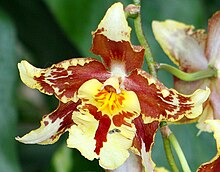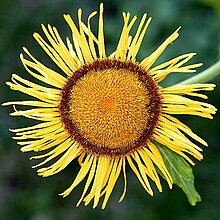Plant reproduction
This article needs additional citations for verification. (March 2023) |
Plant reproduction is the production of new offspring in plants, which can be accomplished by
Asexual reproduction
Asexual reproduction does not involve the production and fusion of male and female gametes. Asexual reproduction may occur through
Asexual reproduction is a type of reproduction where the offspring comes from one parent only, thus inheriting the characteristics of the parent. Asexual reproduction in plants occurs in two fundamental forms, vegetative reproduction and agamospermy.[1] Vegetative reproduction involves a vegetative piece of the original plant producing new individuals by budding, tillering, etc. and is distinguished from apomixis, which is a replacement of sexual reproduction, and in some cases involves seeds. Apomixis occurs in many plant species such as dandelions (Taraxacum species) and also in some non-plant organisms. For apomixis and similar processes in non-plant organisms, see parthenogenesis.
Natural vegetative reproduction is a
Seeds generated by apomixis are a means of asexual reproduction, involving the formation and dispersal of seeds that do not originate from the fertilization of the
Structures
A
.Prostrate aerial stems, called runners or stolons, are important vegetative reproduction organs in some species, such as the strawberry, numerous grasses, and some ferns.
Bulbous plants such as
Usage
The most common form of plant reproduction used by people is seeds, but a number of asexual methods are used which are usually enhancements of natural processes, including: cutting, grafting, budding,
In horticulture, a cutting is a branch that has been cut off from a mother
Examples include cuttings from the stems of
Since vegetatively propagated plants are clones, they are important tools in plant research. When a clone is grown in various conditions, differences in growth can be ascribed to environmental effects instead of genetic differences.[7]
Sexual reproduction
| Part of a series on |
| Sex |
|---|
 |
| Biological terms |
| Sexual reproduction |
|
| Sexuality |
| Sexual system |
Sexual reproduction involves two fundamental processes:
The gametophyte is the multicellular structure (plant) that is
The fusion of male and female gametes (fertilization) produces a diploid zygote, which develops by mitotic cell divisions into a multicellular sporophyte.
The mature sporophyte produces spores by meiosis, sometimes referred to as reduction division because the chromosome pairs are separated once again to form single sets.
In mosses and liverworts, the gametophyte is relatively large, and the sporophyte is a much smaller structure that is never separated from the gametophyte. In ferns, gymnosperms, and flowering plants (angiosperms), the gametophytes are relatively small and the sporophyte is much larger. In gymnosperms and flowering plants the megagametophyte is contained within the ovule (that may develop into a seed) and the microgametophyte is contained within a pollen grain.
History of sexual reproduction of plants
Unlike animals, plants are immobile, and cannot seek out sexual partners for reproduction. In the evolution of early plants, abiotic means, including water and much later, wind, transported
It is believed that insects fed on the pollen, and plants thus evolved to use
Flowering plants
Flowering plants, the dominant plant group,[9]: 168 reproduce both by sexual and asexual means. Their distinguishing feature is that their reproductive organs are contained in flowers. Sexual reproduction in flowering plants involves the production of separate male and female gametophytes that produce gametes.
The
Pollination

Plants that use insects or other animals to move pollen from one flower to the next have developed greatly modified flower parts to attract pollinators and to facilitate the movement of pollen from one flower to the insect and from the insect to the next flower. Flowers of wind-pollinated plants tend to lack petals and or sepals; typically large amounts of pollen are produced and pollination often occurs early in the growing season before leaves can interfere with the dispersal of the pollen. Many trees and all grasses and sedges are wind-pollinated.
Plants have a number of different means to attract pollinators including color, scent, heat, nectar glands, edible pollen and flower shape. Along with modifications involving the above structures two other conditions play a very important role in the sexual reproduction of flowering plants, the first is the timing of flowering and the other is the size or number of flowers produced. Often plant species have a few large, very showy flowers while others produce many small flowers, often flowers are collected together into large inflorescences to maximize their visual effect, becoming more noticeable to passing pollinators. Flowers are attraction strategies and sexual expressions are functional strategies used to produce the next generation of plants, with pollinators and plants having co-evolved, often to some extraordinary degrees, very often rendering mutual benefit.

The largest family of flowering plants is the orchids (
Another large group of flowering plants is the Asteraceae or sunflower family with close to 22,000 species,[11] which also have highly modified inflorescences composed of many individual flowers called florets. Heads with florets of one sex, when the flowers are pistillate or functionally staminate or made up of all bisexual florets, are called homogamous and can include discoid and liguliflorous type heads. Some radiate heads may be homogamous too. Plants with heads that have florets of two or more sexual forms are called heterogamous and include radiate and disciform head forms.
Ferns
Ferns typically produce large diploids with stem, roots, and leaves. On fertile leaves
Bryophytes
The
Dispersal and offspring care
One of the outcomes of plant reproduction is the generation of seeds, spores, gemmae and other vegetative organs that allow plants to move to new locations or new habitats.[citation needed]
Plants do not have nervous systems or any will for their actions. Even so, scientists are able to observe mechanisms that help their offspring thrive as they grow. All organisms have mechanisms to increase survival in offspring.[citation needed]
Offspring care is observed in the Mammillaria hernandezii, a small cactus found in Mexico. A cactus is a type of succulent, meaning it retains water when it is available for future droughts. M. hernandezii also stores a portion of its seeds in its stem, and releases the rest to grow.[13] This can be advantageous for many reasons. By delaying the release of some of its seeds, the cactus can protect these from potential threats from insects, herbivores, or mold caused by micro-organisms. A study found that the presence of adequate water in the environment causes M. Hernandezii to release more seeds to allow for germination. The plant was able to perceive a water potential gradient in the surroundings, and act by giving its seeds a better chance in this preferable environment.[14] This evolutionary strategy gives a better potential outcome for seed germination
There are similar reproductive strategies found in both mammals and plants. A divergence between the two is that in harsh environmental conditions, mammals produce fewer and larger offspring,[citation needed] whereas plants produce more seeds.[15]
See also
References
- ISBN 978-0-226-03816-2.
- ISBN 978-0-226-26554-4.
- ^ "Why apomixis is genetic gold - Australian Life Scientist". Archived from the original on 2009-10-26. Retrieved 2009-10-25.
- ^ ISBN 978-1-5272-2630-2.
- ^ "Ferns and Fern Allies of Wisconsin". University of Wisconsin. Retrieved 8 March 2022.
- ISBN 978-1-4018-4188-1.
- ^ ISBN 978-0-85092-394-0.
- ISBN 978-0-7668-1567-4.
- ISBN 0-87893-403-0.
- ^ Orchidaceae in Flora of North America @ efloras.org
- ^ Asteraceae in Flora of North America @ efloras.org
- ^ Lovett Doust, Jon, and Lesley Lovett Doust. 1988. Plant reproductive ecology: patterns and strategies. New York: Oxford University Press. P 290.
- PMID 23345416.
- ISSN 2296-701X.
- S2CID 59143904.
External links
 Media related to Plant reproduction at Wikimedia Commons
Media related to Plant reproduction at Wikimedia Commons- Simple Video Tutorial on Reproduction in Plant
